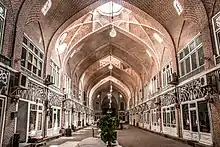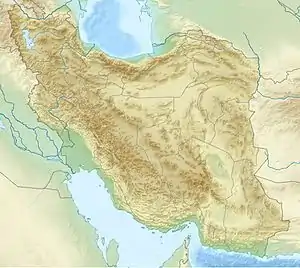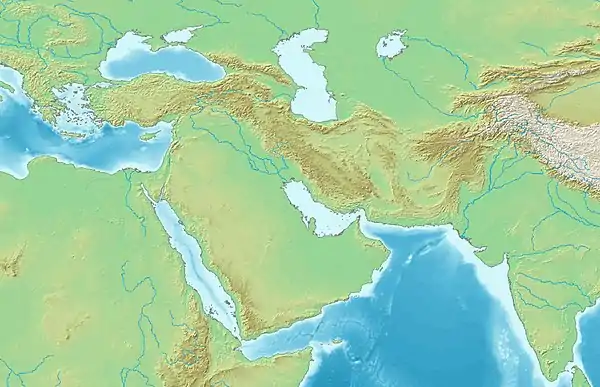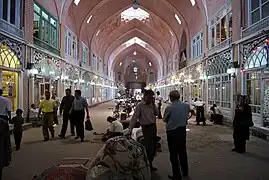| UNESCO World Heritage Site | |
|---|---|
 Mozaffariyeh, Grand Bazzar of Tabriz, Iran | |
| Location | Tabriz, Iran |
| Criteria | Cultural: ii, iii, iv |
| Reference | 1346 |
| Inscription | 2010 (34th Session) |
| Area | 28.9733 ha |
| Buffer zone | 75.4082 ha |
| Coordinates | 38°04′51″N 46°17′32″E / 38.08083°N 46.29222°E |
 Location of Bazaar of Tabriz in Iran  Bazaar of Tabriz (West and Central Asia) | |
The Bazaar of Tabriz (Persian: بازار تبریز, also Romanized as Bāzār-e Tabriz Azerbaijani: تبریز بازاری, also Romanized as Tabriz Bazari) is a historical market situated in the city center of Tabriz, Iran. It is one of the oldest bazaars in the Middle East and the largest covered bazaar in the world.[1] It is one of Iran's UNESCO World Heritage Sites.[2]
History
Tabriz has been a place of cultural exchange since antiquity. Its historic bazaar complex is one of the most important commercial centres on the Silk Road. A bazaar has existed on the same site since the early periods of Iranian urbanism following Islam. The bazaar was mentioned by the Venetian traveler Marco Polo, who claimed to have passed through it while journeying on the Silk Road. [3]
Al-Maqdisi in 10th century, Yaqut al-Hamawi in ca. 1213 CE, Zakariya al-Qazwini in ca. 1252 CE, Marco Polo in 1271 CE, Odoric of Pordenone in ca. 1321 CE, Ibn Battuta in ca. 1330 CE, Ambrogio Contarini in 1474 CE, Hamdallah Mustawfi in around 13th to 14th century, John Cartwright in 1606 CE, Jean Chardin at the time of Suleiman I of Persia, Jean-Baptiste Tavernier in ca. 1636 CE, Giovanni Francesco Gemelli Careri in ca. 1642 CE and dozens of other explorers and historians have written about the Bazaar of Tabriz, which shows its importance and significance during the different periods of time.[4]
Located in the center of the city of Tabriz, Iran, the structure is divided into rows, many devoted to particular categories of product. These include Amir Bazaar (for gold and jewelry), Mozzafarieh (hand woven rugs, sorted by knot size and type), Bashmakhchi Bazaar (shoes), Kiz Basdi Bazaar, and Rahli Bazaar (produce). Tabriz and its bazaar were at their most prosperous in the 16th century, when the town became the capital city of the Safavid kingdom. The city lost this status in the 17th century, but its bazaar has remained important as a commercial and economic hub in the region and on the silk road.[5] Although numerous modern shops and malls have been established in recent years, Tabriz Bazaar has kept its vital role as economic hub of the city and northwestern Iran.[6]
The bazaar was inscribed as a World Heritage Site by UNESCO in July 2010.[7]
Ceremonies
The bazaar is used for some important religious ceremonies.
Restoration
In 2000, the Historical Hermitages Organization of Iran begin a restoration project of the Bazaar, with the full participation of the shop owners. The rehabilitation project won the Aga Khan Award for Architecture in 2013.[8]
Photo gallery
 Mozaffarieh, a major row for hand woven rugs in Tabriz Grand Bazaar.
Mozaffarieh, a major row for hand woven rugs in Tabriz Grand Bazaar. Mozaffariyeh, Bazaar of Tabriz.
Mozaffariyeh, Bazaar of Tabriz. One of two entrance gates to Mozzafariyeh.
One of two entrance gates to Mozzafariyeh. Dome in Amir row of Bazaar.
Dome in Amir row of Bazaar. َCarvansaray near Amir row.
َCarvansaray near Amir row. A caravanserai in the Bazaar of Tabriz.
A caravanserai in the Bazaar of Tabriz. Gan Bazaar, a row in Tabriz Grand Bazaar.
Gan Bazaar, a row in Tabriz Grand Bazaar. Gan Bazaar, translates to wider bazaar, a row in Tabriz Grand Bazaar.
Gan Bazaar, translates to wider bazaar, a row in Tabriz Grand Bazaar.

















See also
- Arabber
- Bazaar
- Blue Mosque, Tabriz
- Constitutional Revolution House of Tabriz
- Hawker centre (Asia) a centre where street food is sold
- Jameh Mosque of Tabriz
- Market (place)
- Peddler
- Retail
- Street vendor
- Street food
References
- ↑ Mehdipour, H.R.N, "Persian Bazaar and Its Impact on Evolution of Historic Urban Cores: The Case of Isfahan," The Macrotheme Review [A multidisciplinary Journal of Global Macro Trends], Vol. 2, no. 5, 2013, p.14
- ↑ "Tabriz Historic Bazaar Complex". UNESCO World Heritage Centre. Retrieved 1 July 2013.
- ↑ Assari,A., Mahesh, T.M., Emtehani, M.E. and Assari, E., "Comparative Sustainability of Bazaar in Iranian Traditional Cities: Case Studies of Isfahan and Tabriz," International Journal on “Technical and Physical Problems of Engineering”, Vol. 3, no. 9, 2011, pp 18-24
- ↑ "بازار بزرگ تبریز". Tabriz Municipality (in Persian). Archived from the original on 25 July 2020. Retrieved 17 November 2022.
- ↑ Assari, Ali; Mahesh, Talkad; Emtehani, Mohammed; Assari, Erfan (December 2011). "Comparative sustainability of bazaar in Iranian traditional cities: case studies in Isfahan and Tabriz" (PDF). International Journal on Technical and Physical Problems of Engineering. 3 (9): 18–24.
- ↑ Editorial Board, East Azarbaijan Geography, Iranian Ministry of Education, 2000 Text Book in Persian Archived June 16, 2008, at the Wayback Machine
- ↑ "World Heritage Committee inscribes seven cultural sites on World Heritage List". UNESCO World Heritage Centre. 31 July 2010.
- ↑ "Rehabilitation of Tabriz Bazaar". Aga Khan Development Network. Archived from the original on 6 July 2013. Retrieved 1 July 2013.
Further reading
- Gregorian, Vartan (2003). The Road to Home: My Life and Times. New York: Simon & Schuster.
- Levinson, David; Christensen, Karen (2002). Encyclopedia of Modern Asia. New York: Scribner's.
- Swiętochowski, Thaddeus (1995). Russia and Azerbaijan: A Borderland in Transition. New York: Columbia University Press.
- Hosseini, Hamid-Rezā (2 August 2010). "وسیع ترین بازار ایران" [Largest bazaar in Iran]. Jadid Online. (in Persian)
External links
- Tishineh
- "The Grand Bazaar of Tabriz" (audio slideshow with English subtitles). Jadid Online.
